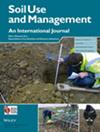How residual plastic film affects the soil water–salt and cotton growth at the seeding stage
IF 3.7
3区 农林科学
Q1 SOIL SCIENCE
引用次数: 0
Abstract
Cotton holds a significant position among cash crops in China, with Xinjiang serving as the primary cotton‐growing region within the country. Agricultural practices involving plastic mulching have gained importance. However, the presence of residual plastic film affects the growth of cotton seedlings as well as the soil environment. Our study aimed to explore the impact of residual plastic film accumulation on the growth of cotton seedlings and the associated soil water‐salt environment. This was done through a barrel planting experiment, utilizing soil from cotton fields with varying durations of mulching. The study showed that when the mulching period exceeded 12 years (residual plastic film content of 260.77 kg hm残留塑料薄膜如何影响播种阶段的土壤水盐分和棉花生长
棉花在中国经济作物中占有重要地位,新疆是中国主要的棉花种植区。使用塑料地膜覆盖的农业措施越来越受到重视。然而,残留塑料薄膜会影响棉苗的生长和土壤环境。我们的研究旨在探讨残留塑料薄膜的积累对棉花幼苗生长和相关土壤水盐环境的影响。我们利用不同覆膜时间的棉田土壤进行了桶式种植实验。研究表明,当地膜覆盖时间超过 12 年(残留塑料薄膜含量为 260.77 kg hm-2)时,残留塑料薄膜对棉花幼苗的生长和土壤环境有显著影响。残留塑料薄膜使棉花幼苗发芽率降低达 11.11%(灌溉后 7 天,覆膜 15 年,残留塑料薄膜含量为 309.88 kg hm-2)。它还会阻碍棉花幼苗的生长;株高、茎粗和叶面积分别减少 34.52%、10.73% 和 37.18%(灌溉后 19 天,覆膜 15 年,残留塑料薄膜含量为 309.88 kg-hm-2)。与没有残留塑料薄膜的处理相比,T5 处理的浅层土壤含水量降低了 1.19%(灌溉后 10 天,覆膜 15 年,残留塑料薄膜含量为 309.88 kg-hm-2)。长期地膜覆盖的棉田中残留的塑料薄膜阻碍了棉苗的正常生长发育,同时也影响了土壤水分和盐分的运输。因此,我们建议采用可生物降解的地膜或定期回收地膜覆盖区域内的残留塑料薄膜,以防止其积累和产生负面影响。
本文章由计算机程序翻译,如有差异,请以英文原文为准。
求助全文
约1分钟内获得全文
求助全文
来源期刊

Soil Use and Management
农林科学-土壤科学
CiteScore
7.70
自引率
13.20%
发文量
78
审稿时长
3 months
期刊介绍:
Soil Use and Management publishes in soil science, earth and environmental science, agricultural science, and engineering fields. The submitted papers should consider the underlying mechanisms governing the natural and anthropogenic processes which affect soil systems, and should inform policy makers and/or practitioners on the sustainable use and management of soil resources. Interdisciplinary studies, e.g. linking soil with climate change, biodiversity, global health, and the UN’s sustainable development goals, with strong novelty, wide implications, and unexpected outcomes are welcomed.
 求助内容:
求助内容: 应助结果提醒方式:
应助结果提醒方式:


